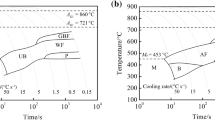Abstract
Hot shortness due to copper and tin in steel is a common industrial problem during the secondary cooling, reheating and hot rolling processes. Silicon is known as a potential element to eliminate hot shortness; however, the effect of single-element silicon on hot shortness and mechanisms involved are not fully understood. The current study aims to determine the Si content needed for a given composition to ameliorate the hot shortness and also to determine the mechanisms. TG, SEM–EDS and XRD were used to study hot shortness behavior of steel containing ~0.3 mass% Cu, ~0.04 mass% Sn and with varying Si-content. It was found that Fe2SiO4 formation at the oxide/steel interface resulting in a reduction of steel oxidation and the enrichment of Cu-rich liquid phase. The mechanisms of silicon eliminating hot shortness were a combination of Fe2SiO4 formation impeding steel oxidation as well as trapping Cu-rich liquid phase into the scale. In the present study, when Si-content is 0.146 mass%, the quantity of Cu-rich liquid phase at the interface was decreased significantly and even no Cu-rich liquid phase was found in the steel with 0.215 mass% Si. Therefore, no less than 0.215 mass% Si was acceptable to alleviate the hot shortness.









Similar content being viewed by others
References
L. G. Garza and C. J. Van Tyne, Journal of Materials Processing Technology 159, 169 (2005).
D. A. Melford, Proceedings of the Royal Irish Acadamy Section A 295, 89 (1980).
J. C. Herman and V. Leroy, Proceedings of 38th mechanical working and steel processing conference Vol. 34 (1996), p. 545.
H. Okamoto, Phase Diagrams for Binary alloys: Desk Handbook, (ASM International, Materials Park, 2000).
J. M. J. Salter, Journal of the Iron and Steel Institute 204, 478 (1966).
T. F. H. Fukagawa, Oxidation of Metals 52, 177 (1999).
B. Webler, L. Yin and S. Sridhar, Metallurgical and Materials Transactions B: Process Metallurgy and Materials Processing Science 39, 725 (2008).
L. Yin, S. Balaji and S. Sridhar, Metallurgical and Materials Transactions B: Process Metallurgy and Materials Processing Science 41, 598 (2010).
N. Imai, N. Komatsubara and K. Kunishige, ISIJ International 37, 224 (1997).
N. Imai, N. Komatsubara and K. Kunishige, ISIJ International 37, 217 (1997).
W. Melfo, H. Bolt, M. Rijnders, et al., ISIJ International 53, 866 (2013).
T. Asai, T. Soshiroda and M. Miyahara, ISIJ International 37, 272 (1997).
B. A. Webler and S. Sridhar, ISIJ International 47, 1245 (2007).
K. Kunishige and M. Hatano, Materials Science Forum 539–543, 4113 (2007).
K. Shibata, S. J. Seo, M. Kaga, et al., Materials Transactions 43, 292 (2002).
B. A. Webler and S. Sridhar, Oxidation of Metals 71, 21 (2009).
E. Sampson and S. Sridhar, Metallurgical and Materials Transactions B: Process Metallurgy and Materials Processing Science 44B, 1124 (2013).
S. Kim and H. Lee, Steel Research International 80, 121 (2009).
L. Yin and S. Sridhar, Metallurgical and Materials Transactions B: Process Metallurgy and Materials Processing Science 2011, 42 (1031).
L. Himmel, R. F. Mehl and C. E. Birchenall, Transactions of AIME 197, 827 (1953).
D. P. Whittle , The International Conference on High Temperature Corrosion. (San Diego, CA, 1981)
J. Stringer, Corrosion Science 10, 513 (1970).
Y. N. Chang and F. I. Wei, Journal Materials Science 24, 14 (1989).
P. Kofstad, Materials and Corrosion 25, 801 (1974).
R. Dieckmann, British Ceramic Transactions 71, 33 (1996).
D. A. Melford, Tetsu to Hagane 200, 290 (1962).
Author information
Authors and Affiliations
Corresponding author
Rights and permissions
About this article
Cite this article
Peng, H. The Role of Silicon in Hot Shortness Amelioration of Steel Containing Copper and Tin. Oxid Met 85, 599–610 (2016). https://doi.org/10.1007/s11085-016-9614-3
Received:
Revised:
Published:
Issue Date:
DOI: https://doi.org/10.1007/s11085-016-9614-3




